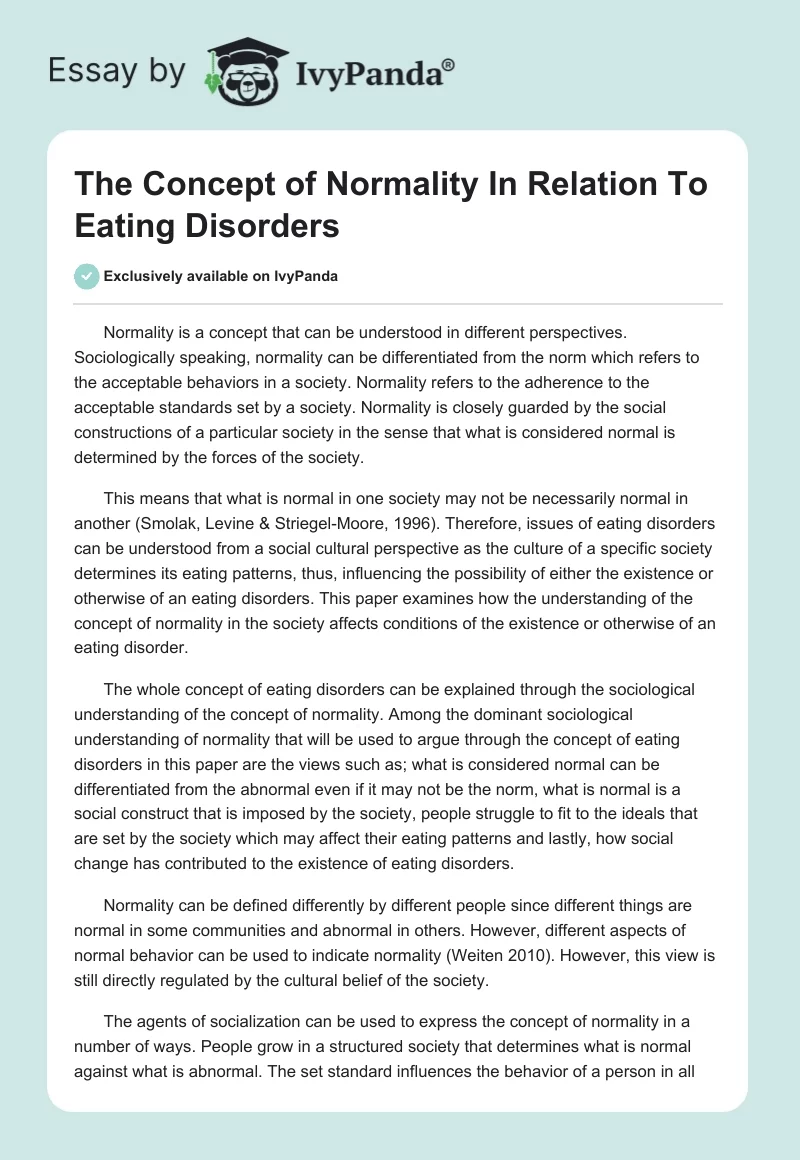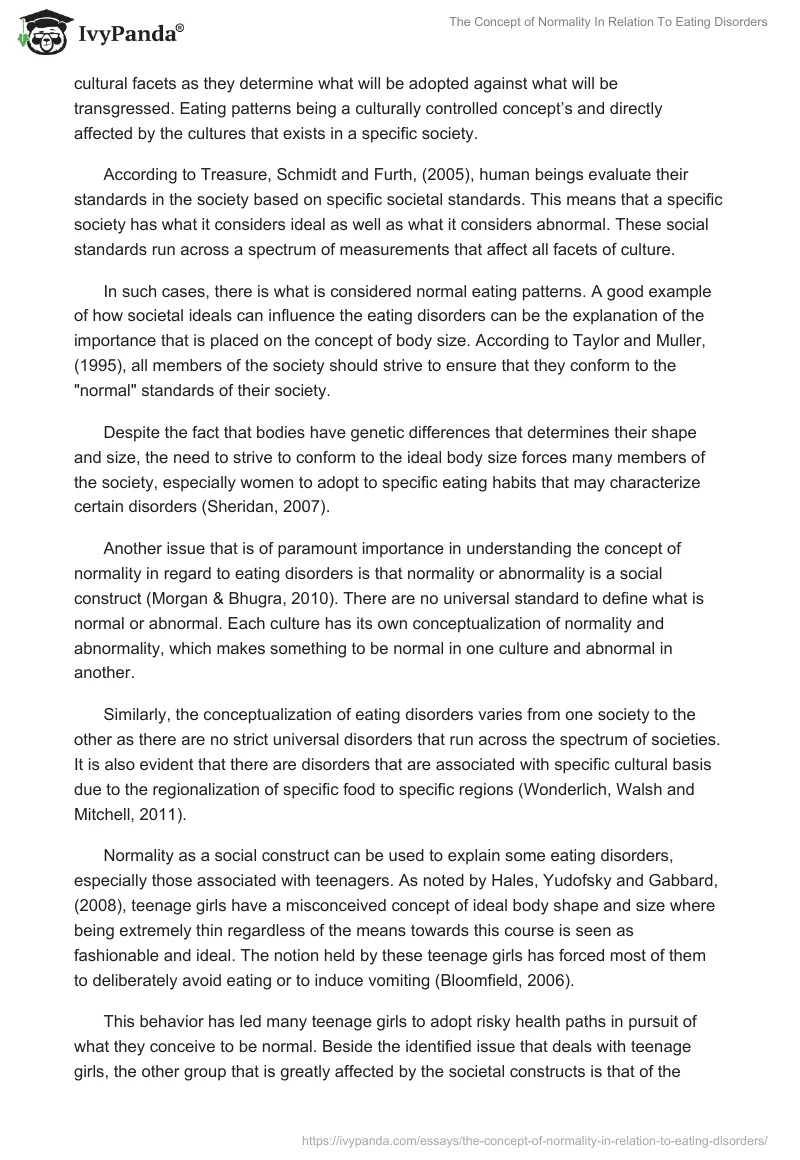Normality is a concept that can be understood in different perspectives. Sociologically speaking, normality can be differentiated from the norm which refers to the acceptable behaviors in a society. Normality refers to the adherence to the acceptable standards set by a society. Normality is closely guarded by the social constructions of a particular society in the sense that what is considered normal is determined by the forces of the society.
This means that what is normal in one society may not be necessarily normal in another (Smolak, Levine & Striegel-Moore, 1996). Therefore, issues of eating disorders can be understood from a social cultural perspective as the culture of a specific society determines its eating patterns, thus, influencing the possibility of either the existence or otherwise of an eating disorders. This paper examines how the understanding of the concept of normality in the society affects conditions of the existence or otherwise of an eating disorder.
The whole concept of eating disorders can be explained through the sociological understanding of the concept of normality. Among the dominant sociological understanding of normality that will be used to argue through the concept of eating disorders in this paper are the views such as; what is considered normal can be differentiated from the abnormal even if it may not be the norm, what is normal is a social construct that is imposed by the society, people struggle to fit to the ideals that are set by the society which may affect their eating patterns and lastly, how social change has contributed to the existence of eating disorders.
Normality can be defined differently by different people since different things are normal in some communities and abnormal in others. However, different aspects of normal behavior can be used to indicate normality (Weiten 2010). However, this view is still directly regulated by the cultural belief of the society.
The agents of socialization can be used to express the concept of normality in a number of ways. People grow in a structured society that determines what is normal against what is abnormal. The set standard influences the behavior of a person in all cultural facets as they determine what will be adopted against what will be transgressed. Eating patterns being a culturally controlled concept’s and directly affected by the cultures that exists in a specific society.
According to Treasure, Schmidt and Furth, (2005), human beings evaluate their standards in the society based on specific societal standards. This means that a specific society has what it considers ideal as well as what it considers abnormal. These social standards run across a spectrum of measurements that affect all facets of culture.
In such cases, there is what is considered normal eating patterns. A good example of how societal ideals can influence the eating disorders can be the explanation of the importance that is placed on the concept of body size. According to Taylor and Muller, (1995), all members of the society should strive to ensure that they conform to the “normal” standards of their society.
Despite the fact that bodies have genetic differences that determines their shape and size, the need to strive to conform to the ideal body size forces many members of the society, especially women to adopt to specific eating habits that may characterize certain disorders (Sheridan, 2007).
Another issue that is of paramount importance in understanding the concept of normality in regard to eating disorders is that normality or abnormality is a social construct (Morgan & Bhugra, 2010). There are no universal standard to define what is normal or abnormal. Each culture has its own conceptualization of normality and abnormality, which makes something to be normal in one culture and abnormal in another.
Similarly, the conceptualization of eating disorders varies from one society to the other as there are no strict universal disorders that run across the spectrum of societies. It is also evident that there are disorders that are associated with specific cultural basis due to the regionalization of specific food to specific regions (Wonderlich, Walsh and Mitchell, 2011).
Normality as a social construct can be used to explain some eating disorders, especially those associated with teenagers. As noted by Hales, Yudofsky and Gabbard, (2008), teenage girls have a misconceived concept of ideal body shape and size where being extremely thin regardless of the means towards this course is seen as fashionable and ideal. The notion held by these teenage girls has forced most of them to deliberately avoid eating or to induce vomiting (Bloomfield, 2006).
This behavior has led many teenage girls to adopt risky health paths in pursuit of what they conceive to be normal. Beside the identified issue that deals with teenage girls, the other group that is greatly affected by the societal constructs is that of the entire female gender where women may be classified as overweight while their male counterparts may pass without acquiring the label of being overweight, even when they are overweight in the real sense.
Thus, more women will strive to conform to the society’s ideal size, a fact that has contributed to various forms of eating disorders. This shows that the concept of what is seen as normal or abnormal towards eating disorders does not necessarily need to be actually healthy, but a construct of the society (Harper-Giuffre and MacKenzie, 1992).
Media as an agent of socialization has a lot of influence to the menace of eating disorders. As noted by Sheridan, (2007), the media plays a significant role in determining what the ideal body size is especially for women. These ideas that are transferred to the masses through commercials and other programs in the media influences the perception of people towards certain body sizes where contemporary cultures have viewed the slim bodies as the ideal ones.
However, when this issue is juxtaposed with the commercials of food known to have high fat content such as fast food products and ice creams, the perception of healthy eating among the members of a population get distorted which forces majority of the people to indulge in unhealthy eating habits as they are “normalized” by the media.
Social change is another aspect that affects or understanding of normality. In most contemporary societies, consumption of fast food is considered normal today than it was considered five decades ago (Gentile, 2006).
The changing social forces such as the rise of the consumerism culture have led to the rise of the number of people who consume fast foods as well as other readymade meals offered in fast food restaurant.
Although many people may have the notion of how unhealthy the fast foods may be to their health, they continue consuming them as the consumption of these products is seen as “normal” in the society. This means that the society understands that eating fast food is a normal issue, a fact that contributes to the current eating disorders.
In conclusion, it is evident that the sociological understanding of the concept of normality can be used to explain various eating disorders. The paper has managed to explain the views of eating disorders in three perspectives, which are the perception of what is normal versus what is abnormal, normality as a construct of the society and finally, personal understanding of normality and eating disorders and how this personal understanding affects people’s conceptualization of their conditions.
Reference List
Bloomfield, S. 2006. Eating Disorders: Helping Your Child Recover. Oklahoma. Beat Publishers.
Gentile, K. 2006. Creating bodies: eating disorders as self-destructive survival New York: Routledge
Hales, R, E. Yudofsky S, C. Gabbard, G, O. 2008. The American Psychiatric Publishing textbook of psychiatry. New York: American Psychiatric Publications
Harper-Giuffre, H. MacKenzie, K., R. 1992. Group psychotherapy for eating disorders Carlifornia: American Psychiatric Pubbications
Morgan, C. and Bhugra, D. 2010. Principles of Social Psychiatry. New York: John Wiley and Sons.
Sheridan, K., E. 2007. Eating disorders as a case study of cultural maladaptation. California: American Psychiatric Publications.
Shils M. and Shike, M. 2006. Modern nutrition in health and disease. Chicago: Lippincott Williams & Wilkins
Smolak, L., P., Levine, M. and Striegel-Moore, R. 1996. The developmental psychopathology of eating disorders: implications for research, prevention, and treatment. New York: Routledge,
Taylor, J., and Muller, D., J.1995. Nursing adolescents: research and psychological perspectives. London. Wiley-Blackwell.
Treasure, J., Schmidt, U. and Furth, E. 2005. The essential handbook of eating disorders New York: John Wiley and Sons.
Weiten, W. 2010. Psychology: Themes and Variations. Upper Saddle River: Cengage Learning.
Wonderlich, S. A., Walsh, T. and Mitchell, J. E. 2011. Developing an Evidence-Based Classification of Eating Disorders: Scientific Findings for DSM-5. California: American Psychiatric Publications.


